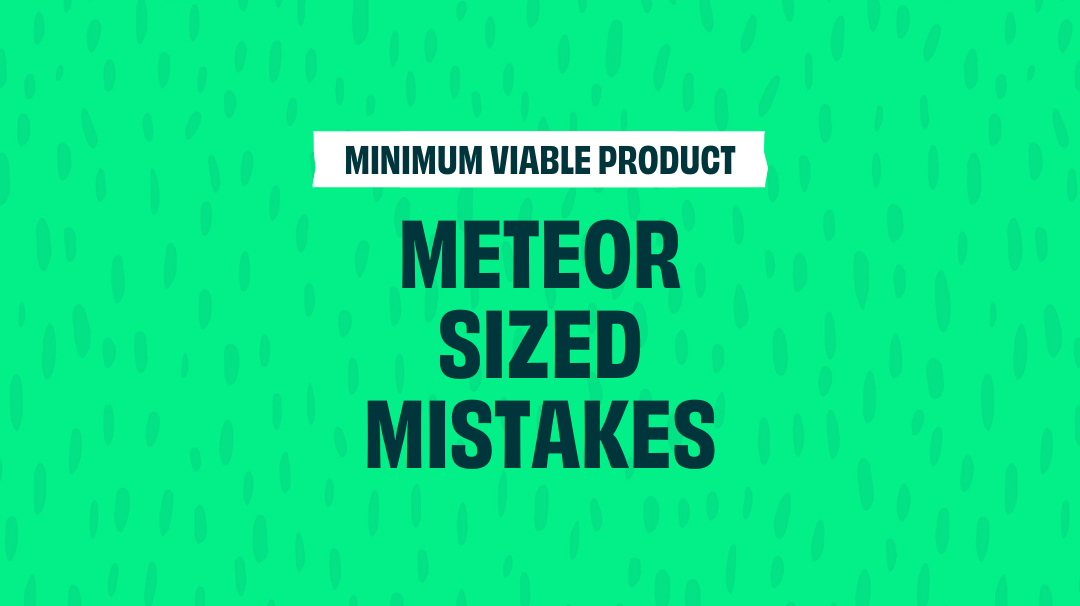This blog post originally appeared on Atlanta Ventures.
At Tyrannosaurus Tech, we talk to a lot of people in a given week, and that is part of what we love about what we do here. We hear big ideas from a diverse array of industries and organizations, from early-stage startups to Fortune 500 companies. We thrive on interacting with these innovators and seeing if we can help them bring their ideas to life.
Whether we’re working with a large enterprise or a small startup, we’re big on lean startup methodologies and of course, the wise pursuit of an “MVP” or minimum viable product. More and more, we see folks are familiar with the concept of an MVP, an initial simple product with very limited features, which is great. MVPs are often developed solely with the intention of on-boarding early adopters to get more feedback in order to verify or shatter your assumptions about what your customers need, want, or will/won’t pay for. In other words, start small, gather feedback, iterate, and repeat.
However, we find there are still a lot of misconceptions about what an MVP is and what it isn’t. In this post, we are going to share some of those most common misconceptions we come across and some tips on how to avoid common pitfalls when developing an MVP.
I Need to Build the Biggest and Best MVP
Don’t forget the M (minimum) in MVP. Entrepreneurs and innovators have huge visions, which is awesome. But you have to start small, as painful as it may be. You know that big beautiful idea you have? Take a machete to it. Trim every feature you conceivably can. Whittle it down to its absolute core. What one feature truly delivers value and can stand alone? Start there. If you feel thrilled about all the awesome things your MVP can do at launch, you may have waited too long or invested too much.
Nice To Have (vs. Must Have) Products Make Great Businesses
Even the best of us can be suckers for a “nice to have” product idea. But let’s be clear, you’re better off creating an aspirin than creating a vitamin. In order to drive adoption and a willingness to pay, your product needs to solve real problems or drive real value for your users. Sure, there are exceptions (hello, Facebook, Twitter, etc.) but the truth is that most successful products are “must have” products. Does your product directly drive revenue? Does it cut costs? If a user adopted your product, how painful would it be for them to later abandon it? How sticky is it? Ask these questions before you think about investing in development.
An MVP Will Help Me Raise Money
Don’t view developing your MVP as a silver bullet for raising money. Even with the slickest MVP in the world, if you don’t have adoption, compelling metrics, a growing user base, hints of product-market fit or early revenue, convincing an investor to throw in is going to be tough. Founders are so eager to succeed and see their vision realized that sometimes they put the cart before the horse. Although it might be part of the larger equation, don’t expect to raise money based on just a shiny MVP.
If I Build It, They Will Come
Just as some view raising money as the cure all, some folks view launching their MVP as the pivotal moment at which their business will take off. An MVP is a living thing that should evolve and cannot simply be checked off the “to do” list. Use your MVP to learn and iterate. Remember, startups are a marathon, not a sprint. And more often than not, success is as much (if not more) about execution than about a great product or great idea. No matter how great your MVP is, it is unlikely early users simply flock to it naturally. Hustling, executing, and driving adoption is what sets successful startups apart for success.
Sure, I’ve Done Enough Customer Discovery
You ran the idea by some family and friends and they think it’s a winner? That’s great, but that is not enough and that is not true customer discovery. Our own brains love to deceive us, and we’re all guilty of convincing ourselves that we’ve got an idea for the next big thing. Do yourself a favor and triple down on customer discovery. Save yourself the heartache (and the money) that comes from jumping into developing something too early. Your friends and family love you and will tell you what you want to hear. Talk to strangers, ask tough questions, listen, and try to disprove your own assumptions. Remember, not building something is a success if building it was going to be a mistake.
“Talk to strangers, ask tough questions, listen, and try to disprove your own assumptions.”
Developing a new product is tricky business, whether you’re a startup or a large company looking to innovate from within. It’s not an exact science, but we hope these tips help anyone out there looking to launch their next great idea.
Richard Simms is the CEO of Tyrannosaurus Tech. As a serial entrepreneur who has worked with and mentored numerous SaaS startups, he has seen the value, lessons, and cost savings that result from the intelligent and meticulous pursuit of an MVP. Even for the sharpest startup founder or innovator, lean startup principles seem to run counter to their entrepreneurial impulses (dream big, have faith in your idea, go for it!) but if followed diligently, they greatly increase the chance for success. Remember, start small, learn, and iterate!


